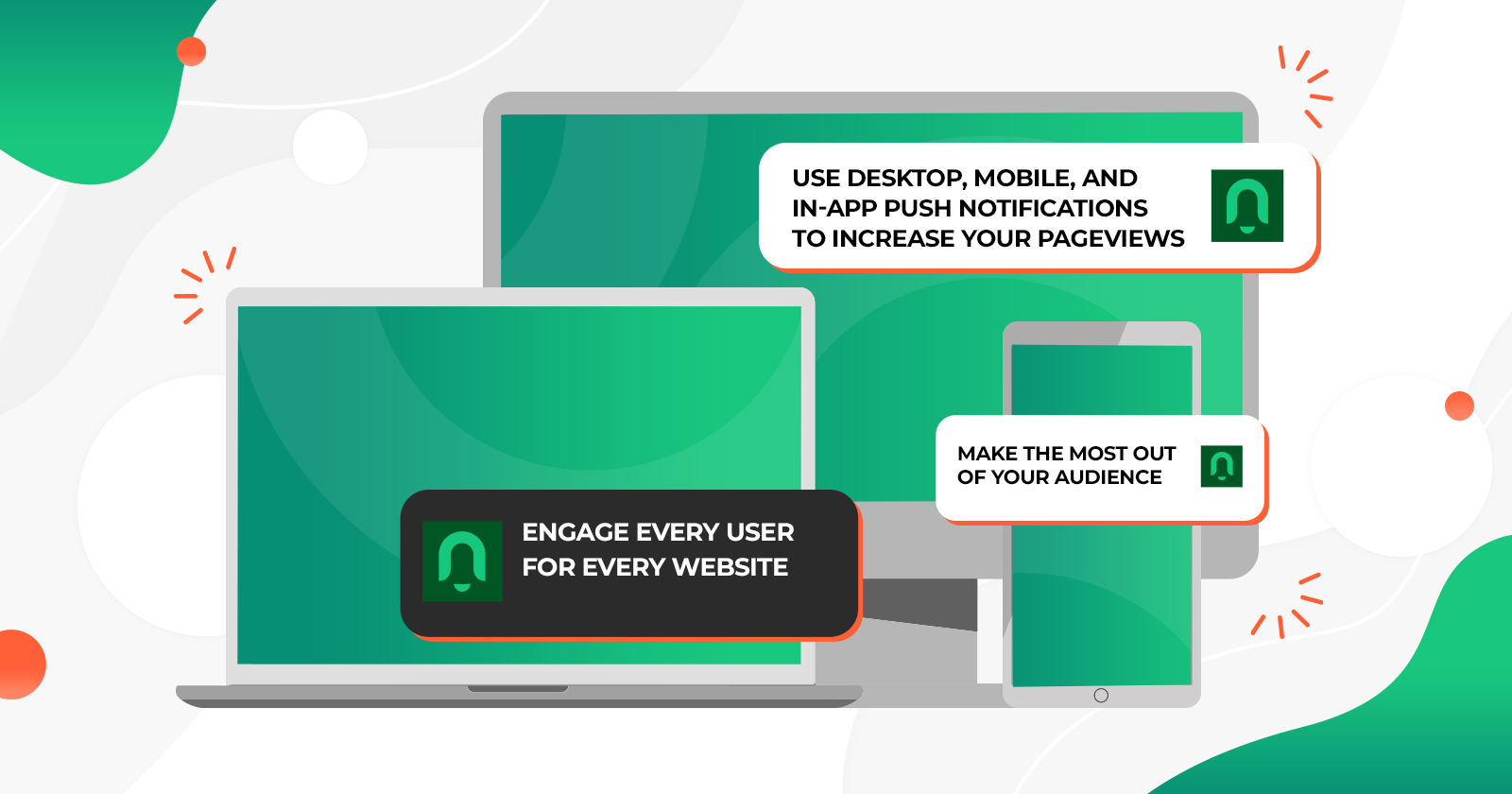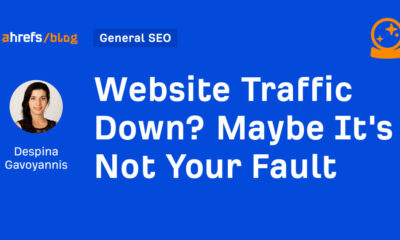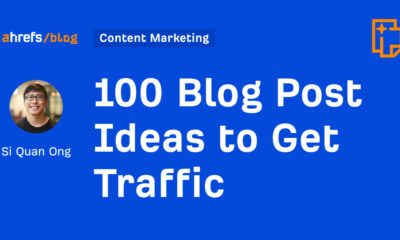SEO
How To Drive Traffic & Engagement With Push Notifications

This post was sponsored by Notix. The opinions expressed in this article are the sponsor’s own.
Do you want to drive more traffic to your website?
Do you need visitors who are engaged with your content to return to your website again and again?
As a publisher, you need a steady stream of engaged traffic to generate revenue from advertising.
In this article, we’re going to look at ways publishers can increase traffic with Notix push notifications.
How Major Publishers Generate Traffic
According to Similarweb, publishers like New York Times (nytimes.com) receive over 40% of their traffic from organic search, 6% from social media, 4% from referrals, and 2% from emails. The majority of traffic comes from direct sources (46%).
The Wall Street Journal (wsj.com) receives over 30% from organic search, 7% from social media, 7% from referrals, and 1% from emails. Like the New York Times, the majority of traffic comes from direct sources (53%).
Direct sources of traffic can be harder to pinpoint, but often include returning visitors who enter the URL of the website into the browser or use a saved bookmark.
Website analytics tools like Google Analytics will also reveal the number of visitors who are new to your site versus the number of returning visitors.
You can analyze the behavior of these visitors to see which traffic is most engaged with your content between the time spent on-page and the average number of page viewers between both segments of visitors.
How do you create a higher amount of returning visitors, who appear to make up a large piece of traffic that comes from direct sources?
- Subscription Lists.
- Push Notifications.
Email & Social Media Subscribers: Common Challenges Of Subscription Lists
To convert a visitor into a subscriber, many publishers will use email opt-in in various formats throughout the website.
When it comes to increasing that returning visitor number, there are a few specific challenges when it comes to email opt-ins.
- You are dependent on the visitor to correctly enter their email address.
- You are dependent on the email server to deliver your email to the subscriber’s inbox instead of their spam box – assuming they haven’t created a filter to sort your email into a folder other than the inbox.
- You are dependent on the subscriber to open your emails and click through to your website for return traffic.
Publishers also rely on social media to help keep visitors loyal to their content.
Challenges can arise when converting new visitors to returning visitors using social media channels.
- You are dependent on the visitor to leave your website and decide to follow you on an external social network.
- You are dependent on the social network to place the posts you make to your social media profile or page in the newsfeed of your new follower.
- You are dependent on your followers to notice your post in their newsfeed and click through to your website for return traffic.
In both cases – the email inbox and social media newsfeed – you are competing against a flood of other messages from acquaintances and other brands that your subscriber follows.
Enter push notifications.
Image created by Adex, March, 2022
Push notifications can be a faster, easier solution to increase the number of returning visitors to your site.
How To Drive Traffic & Engagement With Notix Push Notifications
How do Notix push notifications help publishers generate more returning traffic?
- Instantly implement high-conversion: While a new visitor is enjoying your content, they will be prompted to get instant browser notifications for any new content you publish.
- Capture audiences with ease: With one click of a button to allow notifications, you can convert a new visitor into a subscriber.
- Get seen with high-visibility techniques: When you send a push notification to your subscriber, they will be notified by their browser in the notification center, regardless of what website they are using at the time.
- Get more returning visitors: A higher amount of new visitors become returning visitors, allowing your traffic to increase through visitor repetition, in addition to your constant flow of new visitors.
As you can imagine, the single click to sign up makes it easier to grow your notification list – you don’t have to rely on your visitors to enter a correct email address or follow you after leaving your website.
You are no longer relying on email servers or social media algorithms to properly filter your message into your subscribers’ main view.
You also won’t be working with the personal data of your subscribers as you would with email notifications.
Now that your site is set up with push notifications, how can you make sure they’re performing at their highest potential?
Discover The Best Timing For Push Notifications
Notix push notifications give you the ability to send notifications to all or segments of your subscribers immediately, at a scheduled time, or automatically when you publish new content.
With immediate and scheduled notifications, you can reach your subscribers at the times you think they are most likely to be online and ready to engage with your content.
Scheduled notifications by time zone can help you reach your subscribers at the right time, no matter where they are located in the world.
Automate Your Push Notifications
As a busy publisher, you can also automate your notifications to go out along with your new content.
This allows you to generate return traffic without doing any additional work.
Use Audience Segmentation
To keep your subscribers happy, you can segment your subscribers based on interests and other factors to ensure that the messaging you send fits with their needs.
Websites that cover multiple topics will find this useful when ensuring fans of one topic aren’t fed messages from another.
International publications can use audience segmentation to tailor content to subscribers’ regional interests.
Book A Demo
With a WordPress plugin and free plans for up to 30,000 active subscribers, it’s easy to integrate Notix.
Learn more and book a demo to see how Notix can help you re-engage your visitors with your content and drive valuable return traffic to your website.
Image Credits
Featured Image: Image by Notix. Used with permission.
SEO
Google March 2024 Core Update Officially Completed A Week Ago

Google has officially completed its March 2024 Core Update, ending over a month of ranking volatility across the web.
However, Google didn’t confirm the rollout’s conclusion on its data anomaly page until April 26—a whole week after the update was completed on April 19.
Many in the SEO community had been speculating for days about whether the turbulent update had wrapped up.
The delayed transparency exemplifies Google’s communication issues with publishers and the need for clarity during core updates
Google March 2024 Core Update Timeline & Status
First announced on March 5, the core algorithm update is complete as of April 19. It took 45 days to complete.
Unlike more routine core refreshes, Google warned this one was more complex.
Google’s documentation reads:
“As this is a complex update, the rollout may take up to a month. It’s likely there will be more fluctuations in rankings than with a regular core update, as different systems get fully updated and reinforce each other.”
The aftershocks were tangible, with some websites reporting losses of over 60% of their organic search traffic, according to data from industry observers.
The ripple effects also led to the deindexing of hundreds of sites that were allegedly violating Google’s guidelines.
Addressing Manipulation Attempts
In its official guidance, Google highlighted the criteria it looks for when targeting link spam and manipulation attempts:
- Creating “low-value content” purely to garner manipulative links and inflate rankings.
- Links intended to boost sites’ rankings artificially, including manipulative outgoing links.
- The “repurposing” of expired domains with radically different content to game search visibility.
The updated guidelines warn:
“Any links that are intended to manipulate rankings in Google Search results may be considered link spam. This includes any behavior that manipulates links to your site or outgoing links from your site.”
John Mueller, a Search Advocate at Google, responded to the turbulence by advising publishers not to make rash changes while the core update was ongoing.
However, he suggested sites could proactively fix issues like unnatural paid links.
“If you have noticed things that are worth improving on your site, I’d go ahead and get things done. The idea is not to make changes just for search engines, right? Your users will be happy if you can make things better even if search engines haven’t updated their view of your site yet.”
Emphasizing Quality Over Links
The core update made notable changes to how Google ranks websites.
Most significantly, Google reduced the importance of links in determining a website’s ranking.
In contrast to the description of links as “an important factor in determining relevancy,” Google’s updated spam policies stripped away the “important” designation, simply calling links “a factor.”
This change aligns with Google’s Gary Illyes’ statements that links aren’t among the top three most influential ranking signals.
Instead, Google is giving more weight to quality, credibility, and substantive content.
Consequently, long-running campaigns favoring low-quality link acquisition and keyword optimizations have been demoted.
With the update complete, SEOs and publishers are left to audit their strategies and websites to ensure alignment with Google’s new perspective on ranking.
Core Update Feedback
Google has opened a ranking feedback form related to this core update.
You can use this form until May 31 to provide feedback to Google’s Search team about any issues noticed after the core update.
While the feedback provided won’t be used to make changes for specific queries or websites, Google says it may help inform general improvements to its search ranking systems for future updates.
Google also updated its help documentation on “Debugging drops in Google Search traffic” to help people understand ranking changes after a core update.
Featured Image: Rohit-Tripathi/Shutterstock
FAQ
After the update, what steps should websites take to align with Google’s new ranking criteria?
After Google’s March 2024 Core Update, websites should:
- Improve the quality, trustworthiness, and depth of their website content.
- Stop heavily focusing on getting as many links as possible and prioritize relevant, high-quality links instead.
- Fix any shady or spam-like SEO tactics on their sites.
- Carefully review their SEO strategies to ensure they follow Google’s new guidelines.
SEO
Google Declares It The “Gemini Era” As Revenue Grows 15%

Alphabet Inc., Google’s parent company, announced its first quarter 2024 financial results today.
While Google reported double-digit growth in key revenue areas, the focus was on its AI developments, dubbed the “Gemini era” by CEO Sundar Pichai.
The Numbers: 15% Revenue Growth, Operating Margins Expand
Alphabet reported Q1 revenues of $80.5 billion, a 15% increase year-over-year, exceeding Wall Street’s projections.
Net income was $23.7 billion, with diluted earnings per share of $1.89. Operating margins expanded to 32%, up from 25% in the prior year.
Ruth Porat, Alphabet’s President and CFO, stated:
“Our strong financial results reflect revenue strength across the company and ongoing efforts to durably reengineer our cost base.”
Google’s core advertising units, such as Search and YouTube, drove growth. Google advertising revenues hit $61.7 billion for the quarter.
The Cloud division also maintained momentum, with revenues of $9.6 billion, up 28% year-over-year.
Pichai highlighted that YouTube and Cloud are expected to exit 2024 at a combined $100 billion annual revenue run rate.
Generative AI Integration in Search
Google experimented with AI-powered features in Search Labs before recently introducing AI overviews into the main search results page.
Regarding the gradual rollout, Pichai states:
“We are being measured in how we do this, focusing on areas where gen AI can improve the Search experience, while also prioritizing traffic to websites and merchants.”
Pichai reports that Google’s generative AI features have answered over a billion queries already:
“We’ve already served billions of queries with our generative AI features. It’s enabling people to access new information, to ask questions in new ways, and to ask more complex questions.”
Google reports increased Search usage and user satisfaction among those interacting with the new AI overview results.
The company also highlighted its “Circle to Search” feature on Android, which allows users to circle objects on their screen or in videos to get instant AI-powered answers via Google Lens.
Reorganizing For The “Gemini Era”
As part of the AI roadmap, Alphabet is consolidating all teams building AI models under the Google DeepMind umbrella.
Pichai revealed that, through hardware and software improvements, the company has reduced machine costs associated with its generative AI search results by 80% over the past year.
He states:
“Our data centers are some of the most high-performing, secure, reliable and efficient in the world. We’ve developed new AI models and algorithms that are more than one hundred times more efficient than they were 18 months ago.
How Will Google Make Money With AI?
Alphabet sees opportunities to monetize AI through its advertising products, Cloud offerings, and subscription services.
Google is integrating Gemini into ad products like Performance Max. The company’s Cloud division is bringing “the best of Google AI” to enterprise customers worldwide.
Google One, the company’s subscription service, surpassed 100 million paid subscribers in Q1 and introduced a new premium plan featuring advanced generative AI capabilities powered by Gemini models.
Future Outlook
Pichai outlined six key advantages positioning Alphabet to lead the “next wave of AI innovation”:
- Research leadership in AI breakthroughs like the multimodal Gemini model
- Robust AI infrastructure and custom TPU chips
- Integrating generative AI into Search to enhance the user experience
- A global product footprint reaching billions
- Streamlined teams and improved execution velocity
- Multiple revenue streams to monetize AI through advertising and cloud
With upcoming events like Google I/O and Google Marketing Live, the company is expected to share further updates on its AI initiatives and product roadmap.
Featured Image: Sergei Elagin/Shutterstock
SEO
brightonSEO Live Blog

Hello everyone. It’s April again, so I’m back in Brighton for another two days of Being the introvert I am, my idea of fun isn’t hanging around our booth all day explaining we’ve run out of t-shirts (seriously, you need to be fast if you want swag!). So I decided to do something useful and live-blog the event instead.
Follow below for talk takeaways and (very) mildly humorous commentary. sun, sea, and SEO!
-

 WORDPRESS7 days ago
WORDPRESS7 days ago13 Best HubSpot Alternatives for 2024 (Free + Paid)
-

 MARKETING6 days ago
MARKETING6 days agoAdvertising in local markets: A playbook for success
-

 SEARCHENGINES6 days ago
SEARCHENGINES6 days agoGoogle Core Update Flux, AdSense Ad Intent, California Link Tax & More
-

 SEARCHENGINES5 days ago
SEARCHENGINES5 days agoGoogle Needs Very Few Links To Rank Pages; Links Are Less Important
-

 MARKETING5 days ago
MARKETING5 days agoHow to Use AI For a More Effective Social Media Strategy, According to Ross Simmonds
-

 PPC4 days ago
PPC4 days ago10 Most Effective Franchise Marketing Strategies
-

 SEARCHENGINES3 days ago
SEARCHENGINES3 days agoGoogle Won’t Change The 301 Signals For Ranking & SEO
-

 SEO5 days ago
SEO5 days agoHow to Become an SEO Lead (10 Tips That Advanced My Career)
















You must be logged in to post a comment Login